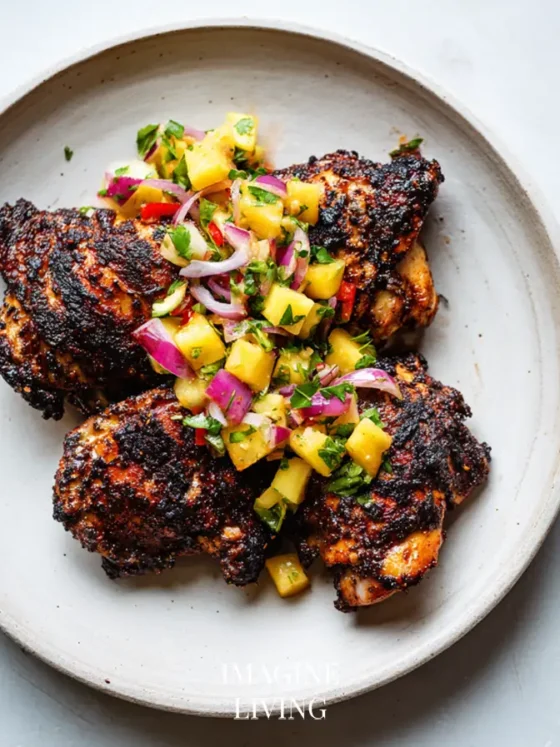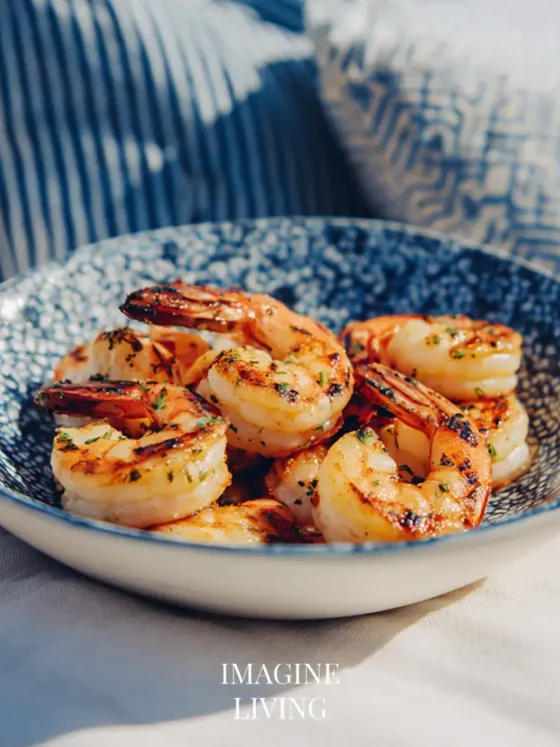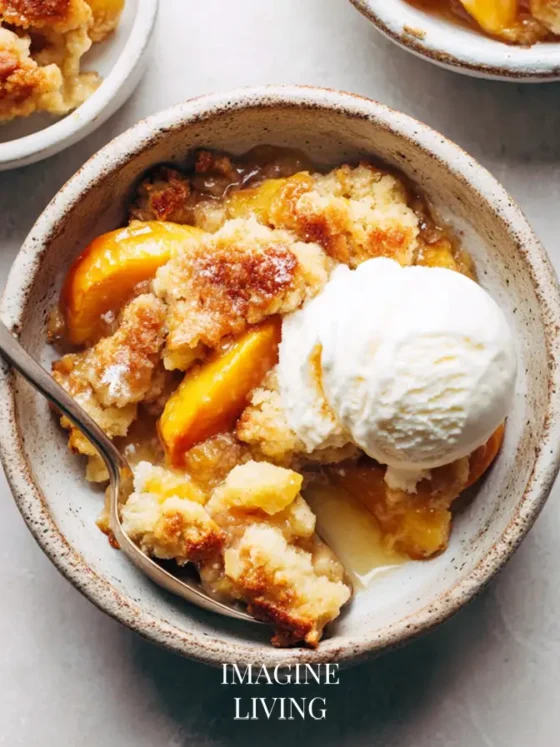Lasagna has a way of bringing people together. Whether it’s a cozy family dinner, a potluck with friends, or meal-prepping for a busy week, this dish is the ultimate crowd-pleaser. But who says it has to be meat-laden to satisfy? A hearty vegetarian lasagna can be just as comforting, if not more so.
I first fell in love with vegetarian lasagna during a trip to Italy. A tiny trattoria in Florence served a layered masterpiece of roasted vegetables, creamy ricotta, and perfectly tender pasta sheets. It was a revelation—proof that vegetables, when treated with care, can outshine any meat-filled counterpart. Since then, I’ve been perfecting my own version, and today, I’m sharing it with you.
A recipe has no soul. You, as the cook, must bring soul to the recipe. — Thomas Keller
Key Takeaways
- Packed with Flavor: Roasted vegetables, creamy ricotta, and melty mozzarella create a symphony of flavors in every bite.
- Satisfying Without Meat: Layers of hearty vegetables and cheese ensure no one misses the meat.
- Make-Ahead Friendly: Perfect for meal prepping or hosting guests.
- Customizable: Add your favorite vegetables or experiment with different cheeses.
- A Family Favorite: Even picky eaters will love this veggie-packed dish.
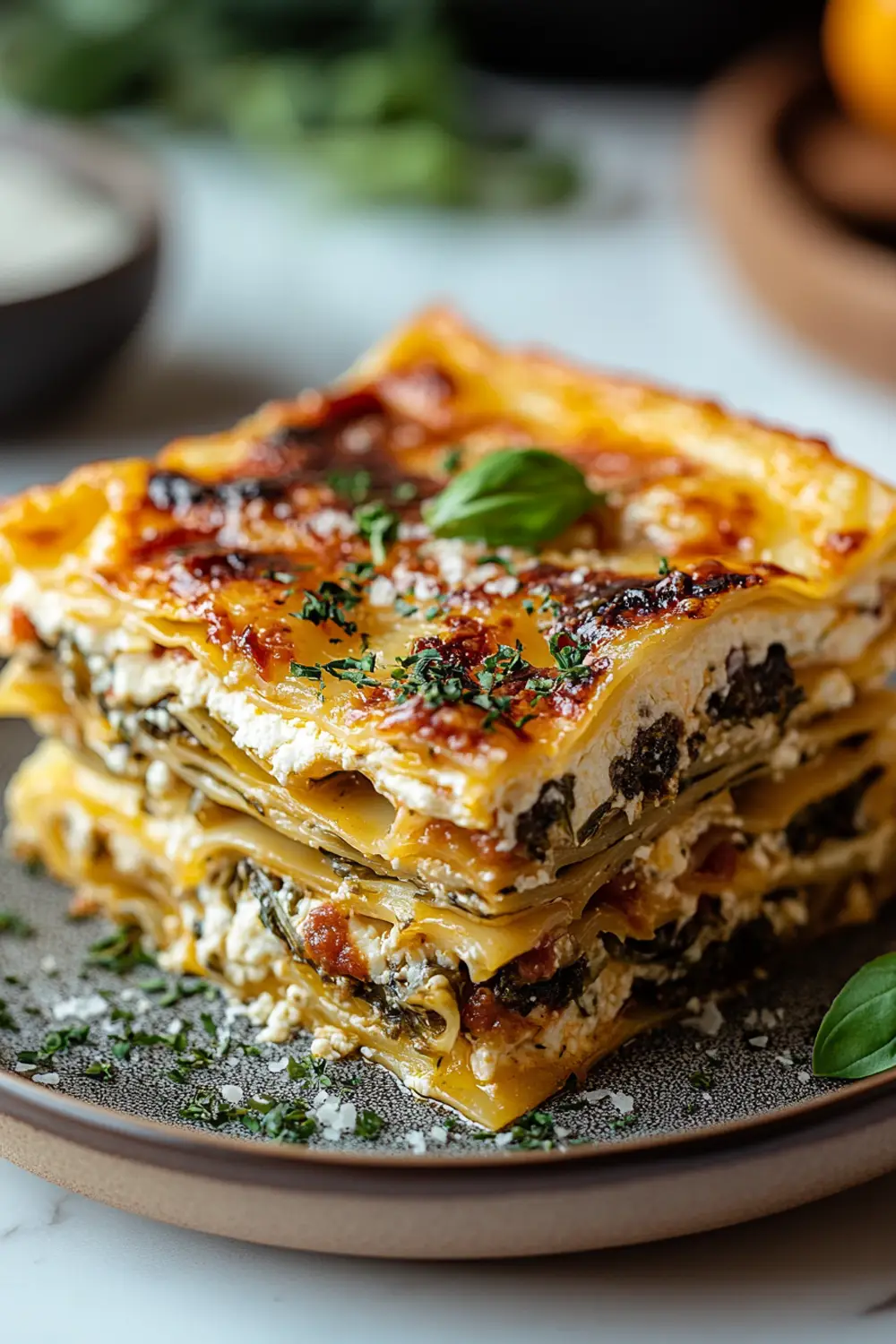
Ingredients: Everything You Need for the Ultimate Vegetarian Lasagna
This recipe makes 12 servings, ideal for sharing or saving leftovers for another day.
For the Roasted Vegetables:
- Zucchini (2 medium, sliced into thin rounds): Adds a tender, slightly sweet layer.
- Eggplant (1 medium, sliced into thin rounds): Provides a rich, meaty texture.
- Red Bell Peppers (2, sliced): Brings a touch of sweetness and color.
- Olive Oil (2 tbsp): For roasting.
- Salt and Pepper (to taste): Essential for seasoning.
For the Sauce:
- Olive Oil (2 tbsp): For sautéing.
- Onion (1 medium, diced): Adds sweetness and depth.
- Garlic (4 cloves, minced): A must for flavor.
- Crushed Tomatoes (2 cans, 28 oz each): The base of the sauce.
- Tomato Paste (2 tbsp): Intensifies the tomato flavor.
- Dried Oregano (1 tsp): For classic Italian flavor.
- Dried Basil (1 tsp): Adds freshness.
- Salt and Pepper (to taste): To balance flavors.
For the Cheese Layers:
- Ricotta Cheese (2 cups): Creamy and rich.
- Spinach (3 cups, chopped): Adds nutrients and freshness.
- Egg (1, large): Helps bind the ricotta layer.
- Mozzarella Cheese (2 cups, shredded): For that gooey, melty finish.
- Parmesan Cheese (1 cup, grated): Adds a salty, nutty touch.
For Assembly:
- Lasagna Noodles (12 sheets, cooked according to package instructions): The foundation of your layers.
Equipment Needed
- Large baking sheet (for roasting vegetables)
- Large pot (for sauce)
- Mixing bowls (for ricotta mixture)
- 9×13-inch baking dish
- Foil (for covering while baking)
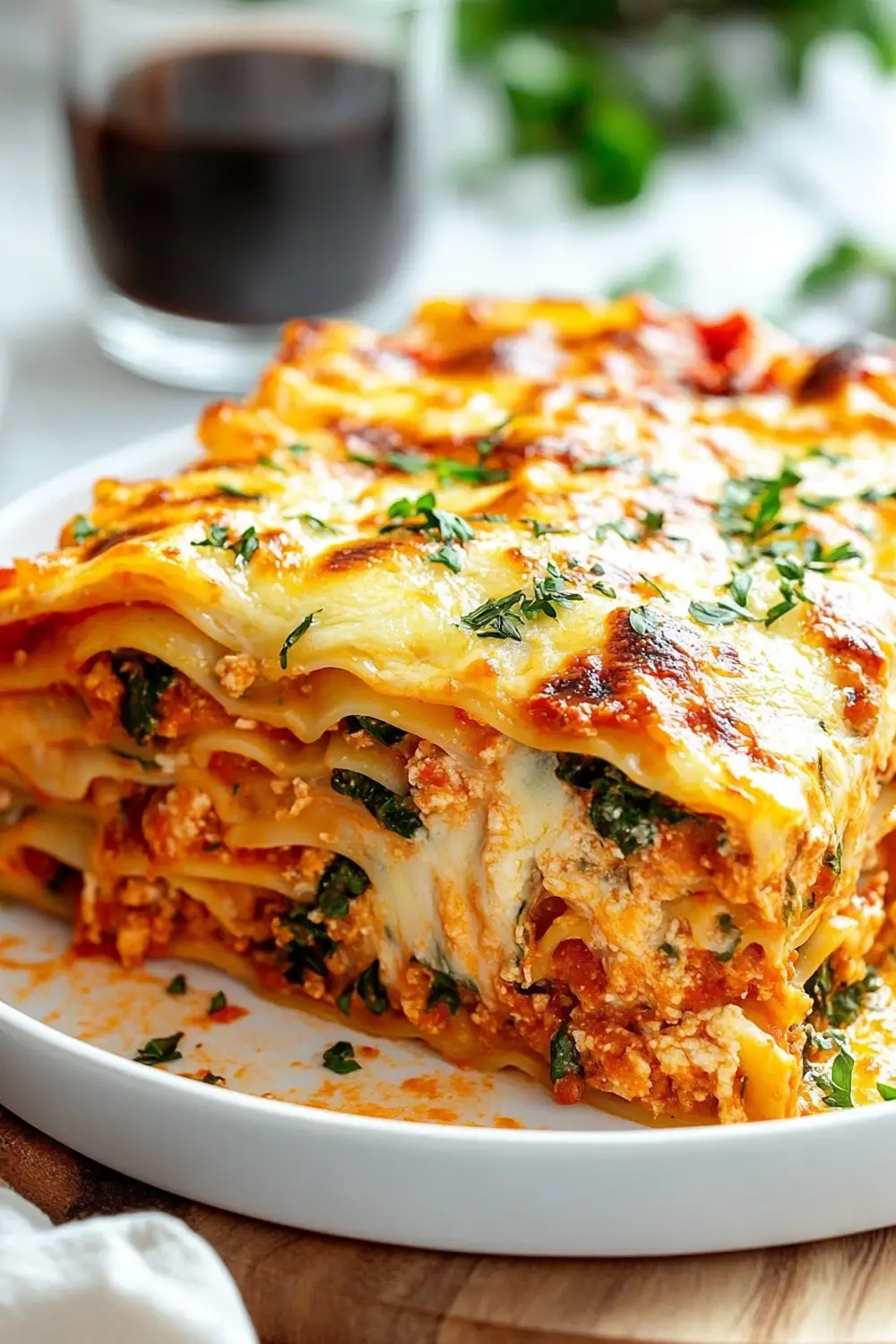
Guide to Making the Perfect Vegetarian Lasagna
Lasagna is a labor of love, but that’s what makes it so rewarding. Each layer represents a piece of the puzzle, coming together to create a dish that’s comforting, satisfying, and full of flavor. This vegetarian version is no exception—it’s hearty, wholesome, and packed with layers of goodness.
Step 1: Roast the Vegetables
Preheat your oven to 400°F (200°C). Toss zucchini, eggplant, and red bell peppers with olive oil, salt, and pepper. Spread evenly on a baking sheet and roast for 20–25 minutes until tender and slightly caramelized.
Tip: For an added layer of flavor, sprinkle a pinch of Italian seasoning over the vegetables as they cook. This enhances their natural sweetness and ties the dish together.
Step 2: Make the Tomato Sauce
In a large pot, heat olive oil over medium heat. Add diced onion and sauté until translucent. Stir in minced garlic and cook until fragrant. Add crushed tomatoes, tomato paste, oregano, basil, salt, and pepper. Simmer for 15–20 minutes, stirring occasionally.
Tip: Add a splash of balsamic vinegar for a subtle tang that elevates the sauce. If you like a bit of heat, a pinch of red pepper flakes does wonders.
Step 3: Prepare the Cheese Mixture
In a mixing bowl, combine ricotta cheese, chopped spinach, egg, half the grated Parmesan, and a pinch of salt and pepper. Stir until well combined.
Tip: For a lighter option, substitute half of the ricotta with cottage cheese—it keeps the dish creamy while reducing the calorie count.
Step 4: Cook the Noodles
Cook lasagna noodles according to package instructions. Drain and lay flat on a clean towel to prevent sticking.
Step 5: Assemble the Lasagna
- Spread a thin layer of tomato sauce on the bottom of the baking dish.
- Add a layer of lasagna noodles, overlapping slightly.
- Spread half the ricotta mixture evenly over the noodles.
- Layer with half the roasted vegetables.
- Sprinkle with shredded mozzarella and a bit of Parmesan.
- Repeat the layers, finishing with a generous layer of mozzarella and Parmesan on top.
Step 6: Bake
Cover with foil and bake at 375°F (190°C) for 25 minutes. Remove the foil and bake for an additional 15 minutes, or until the cheese is bubbly and golden.
Step 7: Rest and Serve
Let the lasagna rest for 10–15 minutes before slicing. This helps the layers set and makes serving easier.
Tip: Sprinkle freshly grated Parmesan and chopped basil over the top just before serving for a touch of elegance.
.
The only thing I like better than talking about food is eating. — John Walters

More Tips for a Flawless Vegetarian Lasagna
Lasagna is all about building layers of flavor and texture. With these tips, you’ll create a dish that’s as satisfying to make as it is to eat.
- Use Fresh Ingredients: Fresh vegetables and high-quality cheeses elevate the dish, making every bite more vibrant and flavorful.
- Layer Strategically: Spread the sauce thinly to avoid soggy noodles and ensure each layer cooks evenly.
- Make It Ahead: Preparing the lasagna a day in advance enhances the flavors while giving you more time to relax before serving.
- Customize Your Veggies: Seasonal additions like mushrooms, kale, or butternut squash bring variety and richness to the dish.
- Let It Rest: Allow the lasagna to cool slightly after baking, which makes slicing easier and helps the layers stay intact.
Serving Suggestions: Elevate Your Lasagna Experience
The right sides and pairings can turn a comforting meal into a special occasion. Think about balancing textures and flavors to create the perfect plate.
- A crisp green salad with a light balsamic vinaigrette adds freshness to balance the richness.
- Serve with warm, buttery garlic bread to complement the savory layers.
- Pair with a glass of red wine like Chianti or Sangiovese for a classic Italian-inspired meal.
Lasagna invites you to slow down and savor—it’s a dish that brings people together.
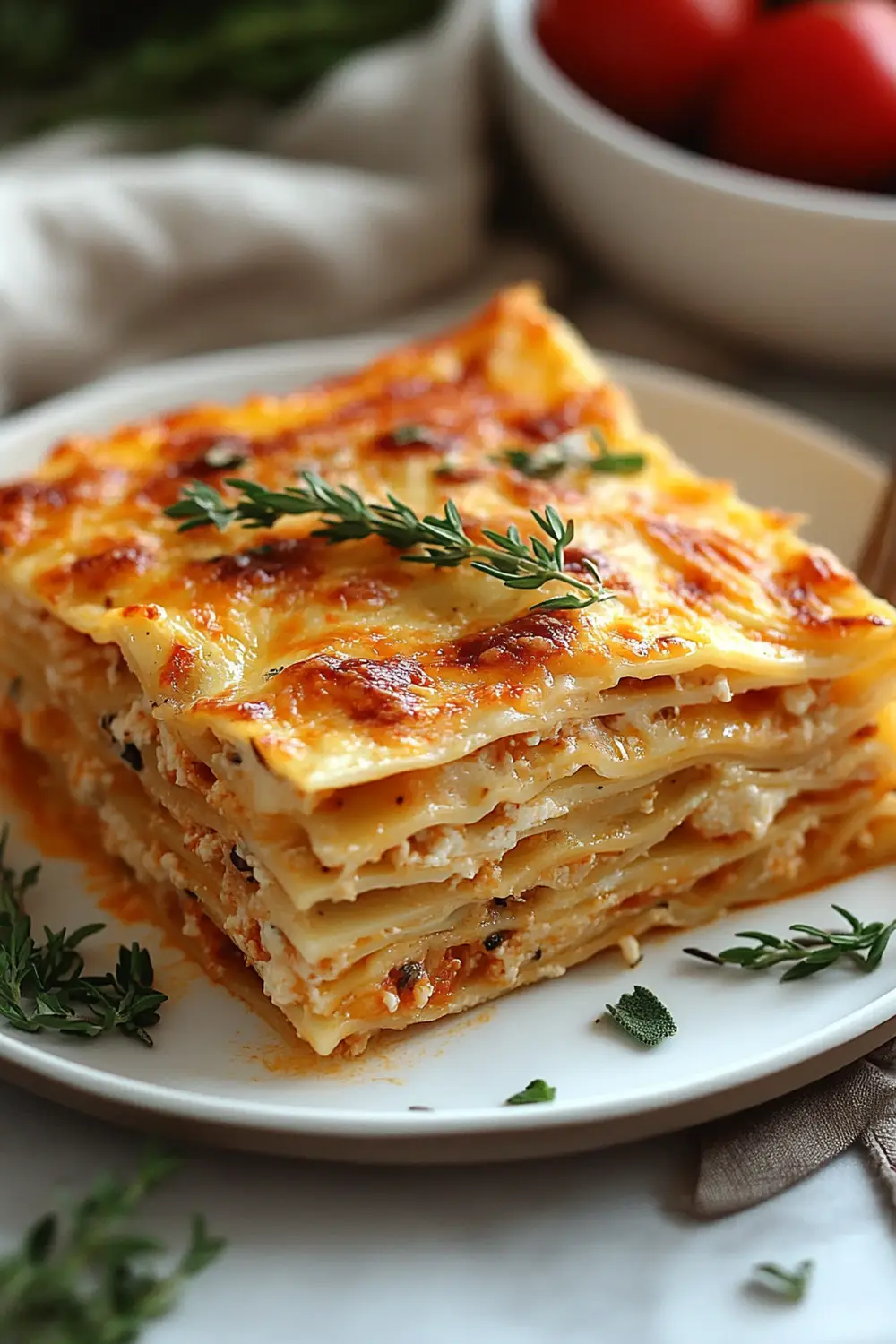
Creative Versions: Variations on Vegetarian Lasagna
Gluten-Free Twist
Swap traditional lasagna noodles for gluten-free alternatives like brown rice or chickpea pasta. For a lighter option, thinly slice zucchini or eggplant and use them as noodle substitutes.
Tip: Lightly salt and pat dry the zucchini or eggplant slices before layering to remove excess moisture. This prevents the lasagna from becoming watery during baking.
Protein-Packed Layers
Add some heartiness with plant-based proteins. Cooked lentils, crumbled tofu, or a mix of beans work wonderfully in the tomato sauce.
Tip: Sauté tofu with smoked paprika and garlic powder to give it a flavorful, meaty texture that complements the sauce.
Spicy Mediterranean Flair
Introduce bold flavors with a spicy tomato sauce. Stir in harissa, chili flakes, or even a touch of sriracha for heat. Add olives, sun-dried tomatoes, and artichoke hearts for a Mediterranean twist.
Tip: Use feta cheese crumbles or dairy-free alternatives for a tangy topping that pairs beautifully with these flavors.
Extra Cheesy Indulgence
If you’re a cheese lover, take it up a notch. Add layers of fontina, gouda, or smoked provolone for a rich, melty experience.
Tip: Sprinkle a mix of Parmesan and breadcrumbs on top before baking for a golden, crispy finish.
Seasonal Sensation
Tailor your lasagna to the seasons. Use roasted butternut squash and caramelized onions in the fall, or fresh cherry tomatoes and zucchini in the summer.
Tip: Roasting the vegetables beforehand deepens their flavor and prevents them from releasing too much water during baking.
International Inspiration
Experiment with global flavors to create a fusion lasagna. Use tikka masala sauce and paneer for an Indian twist, or replace the tomato sauce with béchamel for a French-inspired dish.
Tip: For an Italian-Mexican fusion, add layers of black beans, corn, and salsa with a sprinkle of pepper jack cheese.
Light and Lean
For a lower-carb, veggie-forward option, skip the noodles entirely and layer thin slices of zucchini, sweet potato, or roasted portobello mushrooms instead.
Tip: Bake sweet potato slices first to ensure they’re tender and caramelized before layering.
The beauty of lasagna is its endless versatility—there’s always a way to make it your own and share it with those you love.
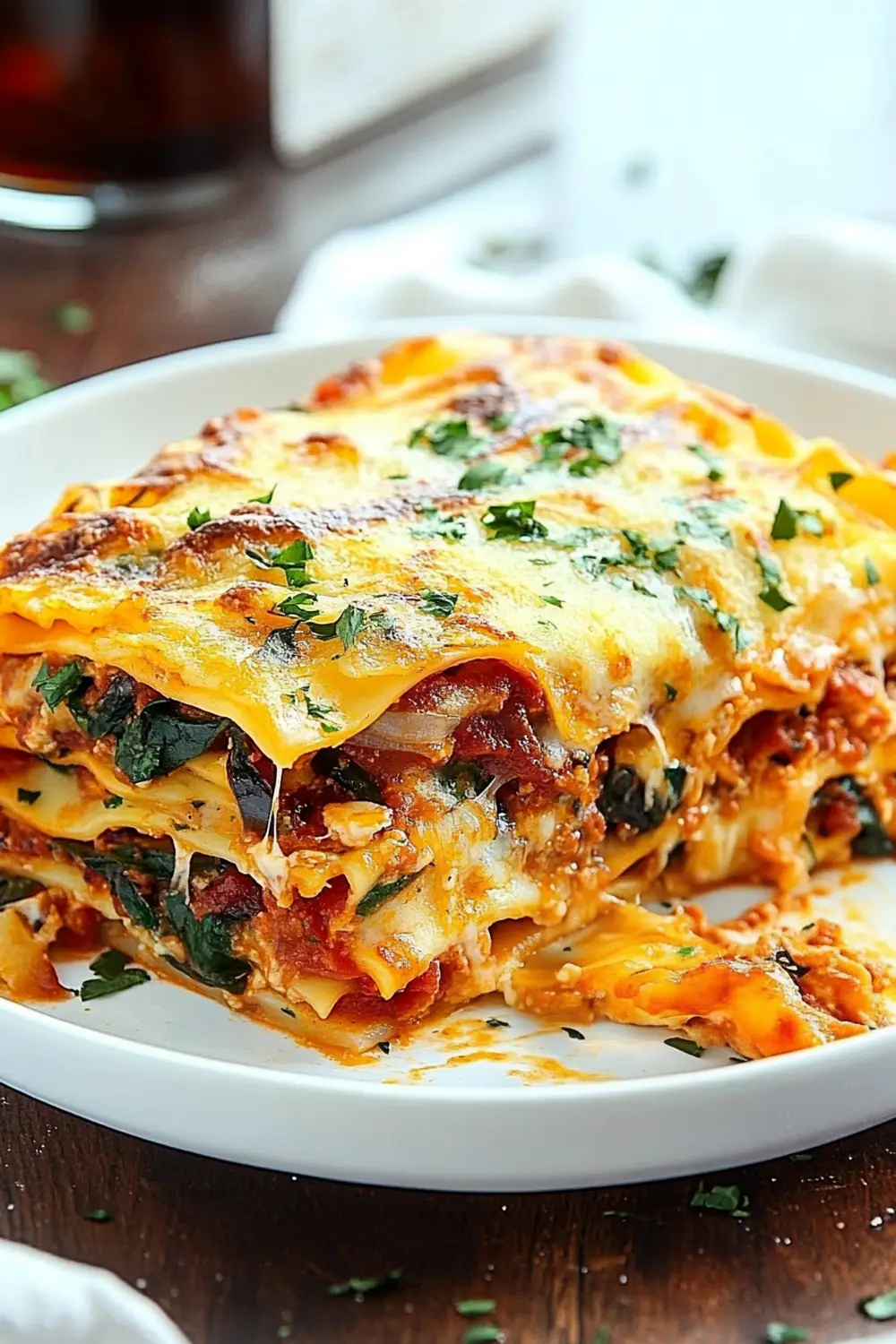
Storage and Reheating: Keeping Your Lasagna Delicious
- Refrigerate: Store leftovers in an airtight container for up to 5 days.
- Freeze: Wrap individual portions tightly in foil and freeze for up to 3 months.
- Reheat: Warm in the oven at 350°F (175°C) until heated through, or microwave individual portions for 2–3 minutes.
Lasagna tastes even better the next day—somehow, the flavors get even richer.
Common Mistakes to Avoid When Making Vegetarian Lasagna
Mistakes happen, even with a dish as forgiving as lasagna. Avoid these common pitfalls to ensure your vegetarian lasagna is a triumph every time.
Overloading with Vegetables
It’s tempting to add a ton of veggies for that hearty, wholesome vibe, but too many can release excess water, leaving your lasagna soggy.
Tip: Sauté or roast your vegetables beforehand to remove moisture and concentrate their flavors. Trust me, it’s worth the extra step.
Skipping the Sauce Layer on the Bottom
Starting with a dry base can cause the noodles to stick or dry out.
Tip: Spread a thin layer of tomato sauce across the bottom of your baking dish before the first layer of noodles. It’s like laying the foundation for a solid house—it keeps everything intact.
Using Raw Vegetables Between Layers
Raw veggies might seem like a time-saver, but they can cook unevenly and release water as they bake.
Tip: Always cook your vegetables beforehand. Roasting or sautéing them adds depth and prevents that watery lasagna situation.
Overcooking the Noodles
Pre-cooking lasagna noodles until they’re fully done can result in mushy layers once baked.
Tip: Cook them until just shy of al dente. They’ll finish cooking in the oven, absorbing the sauce for perfect texture.
Forgetting to Let It Rest
We’ve all been there—too excited to dig in and end up with a messy, collapsing slice.
Tip: Patience pays off. Let your lasagna rest for 10–15 minutes after baking to allow the layers to set for cleaner, prettier slices.
Skipping a Foil Cover
Baking without covering your lasagna can cause the top layer of cheese to brown too quickly while the inside remains undercooked.
Tip: Cover your lasagna with foil for the first 25 minutes of baking. Remove it for the final 10–15 minutes to get that golden, bubbly top.
Cooking is about learning from each pot, each mistake, and turning it into something better next time.
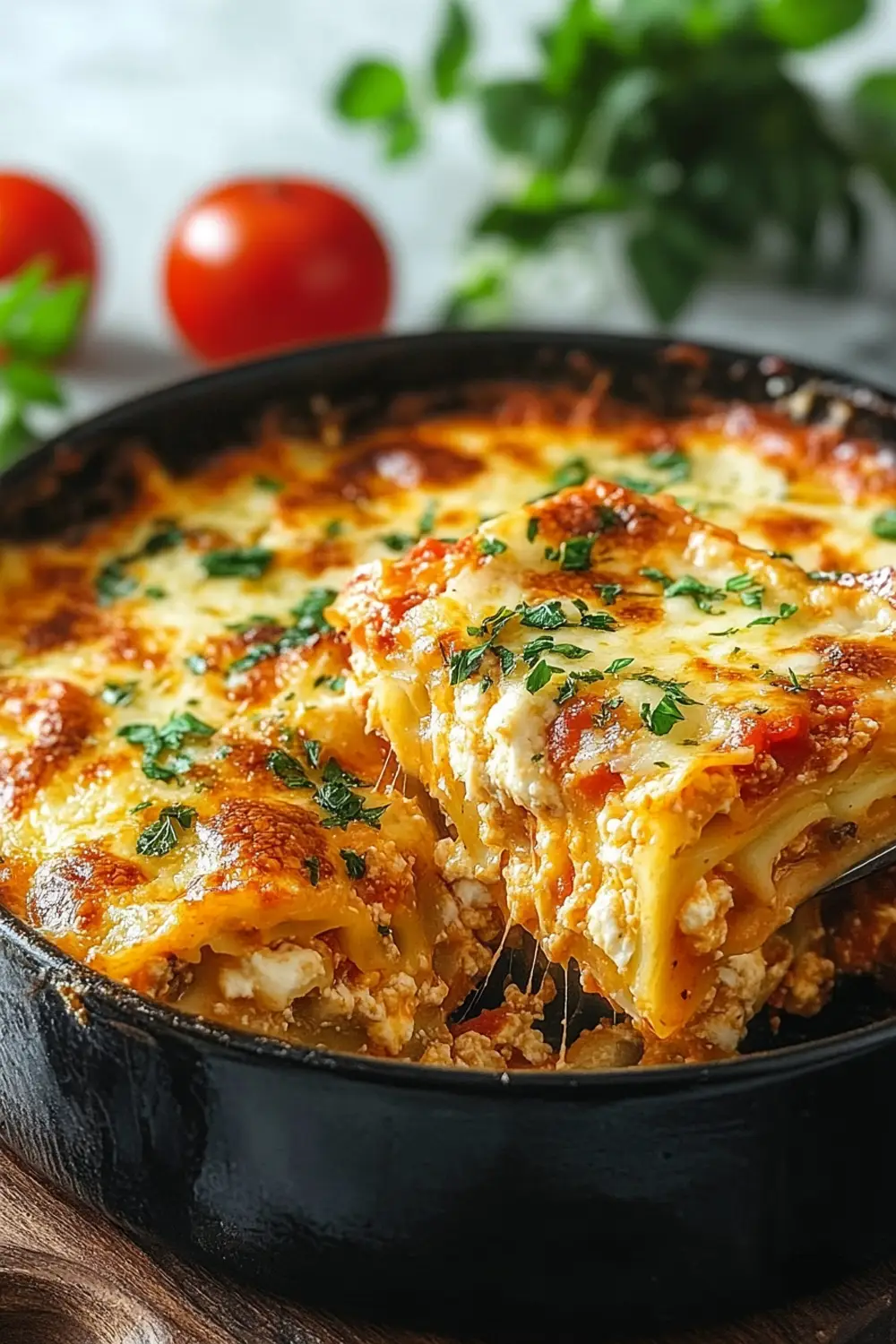
Conclusion
Vegetarian lasagna proves that comfort food doesn’t need meat to shine. With layers of roasted vegetables, creamy ricotta, and rich tomato sauce, it’s a dish that’s as satisfying as it is wholesome. Whether you’re cooking for family, friends, or just yourself, this lasagna is sure to become a staple in your recipe collection.
FAQ
Can I use no-boil noodles?
Yes! Just ensure there’s enough sauce to soften them during baking.
Can I make this vegan?
Absolutely—use plant-based cheeses and a flax egg substitute for the ricotta mixture.
What other vegetables can I use?
Mushrooms, spinach, kale, or squash are great additions.
How do I prevent watery lasagna?
Roast the vegetables first and don’t overload with sauce.
Can I freeze lasagna?
Yes, assemble it first, then freeze before baking. Thaw overnight before cooking.
What’s the best way to reheat leftovers?
Use the oven for even reheating, or microwave individual portions.
How long can I store leftovers?
Refrigerate for up to 5 days or freeze for 3 months.
Do I have to roast the vegetables?
It’s highly recommended for the best flavor, but you can sauté them instead.
What’s a good cheese substitute for ricotta?
Cottage cheese or a mix of cream cheese and Greek yogurt works well.
Can I add protein?
If desired, add cooked lentils or tofu crumbles for a protein boost.
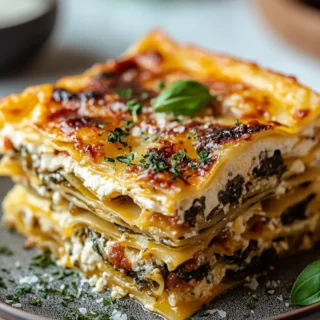
Ultimate Vegetarian Lasagna
Equipment
- Large baking sheet (for roasting vegetables)
- Large pot (for sauce)
- Mixing bowls (for ricotta mixture)
- 9×13-inch baking dish
- Foil (for covering while baking)
Ingredients
For the Roasted Vegetables:
- 2 medium zucchinis sliced into thin rounds
- 1 medium eggplant sliced into thin rounds
- 2 red bell peppers sliced
- 2 tbsp olive oil
- Salt and pepper to taste
For the Sauce:
- 2 tbsp olive oil
- 1 medium onion diced
- 4 cloves garlic minced
- 2 cans 28 oz each crushed tomatoes
- 2 tbsp tomato paste
- 1 tsp dried oregano
- 1 tsp dried basil
- Salt and pepper to taste
For the Cheese Layers:
- 2 cups ricotta cheese
- 3 cups spinach chopped
- 1 large egg
- 2 cups shredded mozzarella cheese
- 1 cup grated Parmesan cheese
For Assembly:
- 12 sheets lasagna noodles cooked according to package instructions
Instructions
Step 1: Roast the Vegetables
- Preheat your oven to 400°F (200°C). Toss zucchini, eggplant, and red bell peppers with olive oil, salt, and pepper. Spread them evenly on a baking sheet and roast for 20–25 minutes until tender and slightly caramelized.
- “Roasting vegetables unlocks their natural sweetness—don’t skip this step.”
Step 2: Make the Sauce
- Heat olive oil in a large pot over medium heat. Add diced onion and sauté until translucent, about 5 minutes. Stir in minced garlic and cook until fragrant, about 1 minute. Add crushed tomatoes, tomato paste, oregano, basil, salt, and pepper. Simmer for 15–20 minutes, stirring occasionally.
Step 3: Prepare the Ricotta Mixture
- In a mixing bowl, combine ricotta cheese, chopped spinach, egg, half the grated Parmesan, and a pinch of salt and pepper. Mix until well combined.
Step 4: Cook the Noodles
- Cook lasagna noodles according to package instructions. Drain and lay flat on a clean towel to prevent sticking.
Step 5: Assemble the Lasagna
- Spread a thin layer of tomato sauce on the bottom of the baking dish.
- Add a layer of lasagna noodles, overlapping slightly.
- Spread half the ricotta mixture evenly over the noodles.
- Layer with half the roasted vegetables.
- Sprinkle with shredded mozzarella and a bit of Parmesan.
- Repeat the layers, finishing with a generous layer of mozzarella and Parmesan on top.
Step 6: Bake the Lasagna
- Cover the baking dish with foil and bake at 375°F (190°C) for 25 minutes. Remove the foil and bake for an additional 15 minutes, or until the cheese is bubbly and golden.
Step 7: Rest and Serve
- Let the lasagna rest for 10–15 minutes before slicing. This step allows the layers to set, making serving easier and cleaner.
Notes
Swap ricotta with vegan cashew cream for a plant-based version.
Store leftovers in the fridge for up to 4 days or freeze for up to 3 months.
- Durable & Safe – Using glass baking dishes often leads to breakage, cracks, and glass shards flying around in the oven, …
- 3 Size Bakeware for Versatile Needs – (Including handles size) 3.5Qt: 13.8″L x 9.1″W x 2.7″H | 2.3Qt: 11.7″L x 7.3″W x 2…
- Exquisite Design & Effortless Cleanup – Featured with glossy porcelain, make the casseroles baking dish never get out of…
This post contains affiliate links. If you purchase through these links, we may earn a small commission at no extra cost to you. As an Amazon Associate, we earn from qualifying purchases. Thank you for your support!


